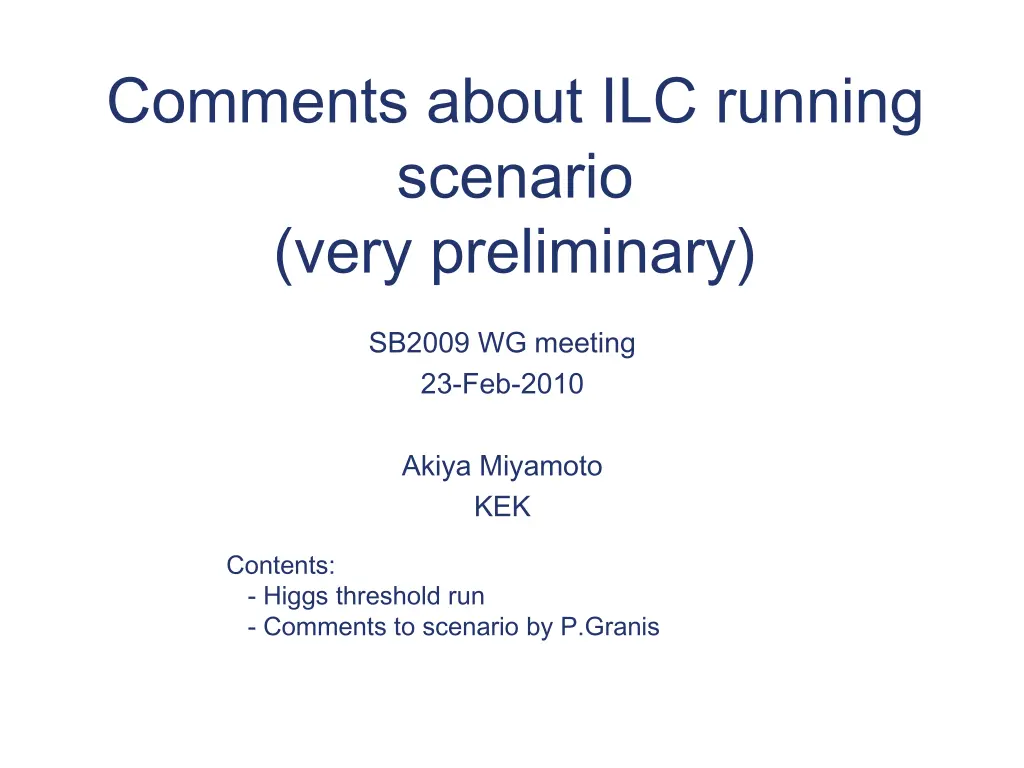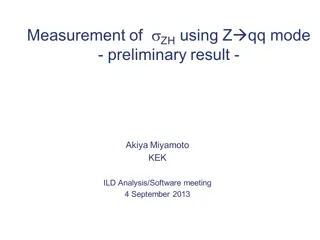
Insights on ILC Running Scenario and Higgs Threshold
Delve into a preliminary analysis of the ILC running scenario from the SB2009 WG meeting, where Akiya Miyamoto of KEK presented on the Higgs threshold run. Detailed comments by P. Granis shed light on crucial aspects including model discrimination and assumed run scenarios. Explore the exploration of the Higgs threshold and SUSY performance comparisons in a comprehensive setting.
Download Presentation

Please find below an Image/Link to download the presentation.
The content on the website is provided AS IS for your information and personal use only. It may not be sold, licensed, or shared on other websites without obtaining consent from the author. If you encounter any issues during the download, it is possible that the publisher has removed the file from their server.
You are allowed to download the files provided on this website for personal or commercial use, subject to the condition that they are used lawfully. All files are the property of their respective owners.
The content on the website is provided AS IS for your information and personal use only. It may not be sold, licensed, or shared on other websites without obtaining consent from the author.
E N D
Presentation Transcript
Comments about ILC running scenario (very preliminary) SB2009 WG meeting 23-Feb-2010 Akiya Miyamoto KEK Contents: - Higgs threshold run - Comments to scenario by P.Granis
Higgs threshold By M.T.Dova, P.G.Abia, W.Lohmann, hep-ph/0302113 (LCWS2002) 20 fb-1each at 215, 222, 240 GeV mh=120 GeV, SIMDET with beamstrahlung. Initial beam energy spread = Tesla ? eeqq/ qq channels only Background processes: ee eeff, qq( ), WW, ZZ Akiya Miyamoto SB2009 WG meeting, 23-Feb-2010 2
Higgs threshold ~ 9.2 % (240 GeV) for 20fb-1 (read from the paper ) with 250 fb-1 ~ 2.6 % consistent with ILD LOI (2.5%) Model discrimination based on values are read from the paper. 20 fb-1 222 4.0 10 both 4.7 5 both 3.3 E(GeV) S=1 215 5.3 both 6.6 6.4 7.2 9.6 6.8 4.8 S=2 Assuming enough data at 230~240 GeV additional 5 fb-1each at 215 and 222 GeV would be OK to rule out S=1 and 2 case Akiya Miyamoto SB2009 WG meeting, 23-Feb-2010 3
Scenario by P.D.Grannis Snowmass 05 Study of Snowmass SM2 point ( ~ SPS1a point ) LOI sps1a : m0=70 GeV, m1/2=250GeV, tan =10, A0=-300, sign =+ 124GeV 124 109.2 96.1 185 185 Chargino/Neutralino study for LOI used the point5 parameter ( not sps1a) Akiya Miyamoto SB2009 WG meeting, 23-Feb-2010 4
Assumed run scenario Total 695 fb-1by true luminosity Total 1000 fb-1by equivalent luminosity ( scaled by 1/E) Akiya Miyamoto SB2009 WG meeting, 23-Feb-2010 5
SUSY performance comparison Stau1 P.Granis: Stau1 endpoint ( 500 GeV, 335 fb-1?) : m(stau1) ~ 1~2 GeV Stau1 scan at 270 GeV, 100fb-1, R pol. : m(stau1) ~0.64GeV ILD LOI (500 GeV, 500fb-1) m(stau1) ~0.1GeV 1.3 (LSP mass) smuonL P.Granis end point ( 500 GeV, 335 fb-1 ?) : m(smuon) ~ 0.7 GeV scan ( 410 GeV, 60 fb-1 ) : m(smuon) ~ 0.7 GeV ILD LOI end point ( 500 GeV, 500 fb-1 ) : m(smuonL) ~ 0.5 GeV End point meas. at 500 GeV may be sufficient for mass meas. Akiya Miyamoto SB2009 WG meeting, 23-Feb-2010 6
Luminosity assumption 2.5 Input: values from GDE other points are by eye interpolation/extrapolation Instatenous Luminosity (cm-2s-1) 2 1.5 P.Granis RDR SB-NoTF SB-wTF 1 0.5 0 0 100 200 300 400 500 600 CM energy (GeV) Akiya Miyamoto SB2009 WG meeting, 23-Feb-2010 7
Comparison of run scenarios ( Note: new scenario 1&2 are not optimized ) ( Leff=500 GeV equiv lum. ) Scenario by P.Granis New Scenario1 New Scenario2 E(GeV ) Pol Lreal L eff Lreal L eff Lreal L eff 1/E RDR SBwTF 1/E RDR SBwTF 1/E RDR SBwTF Top energy Calibration Chi10-CHi20 scan, stau scan smu_R scan tt threshold e_R e_L scan ( L& R pol.) chi1+ chi1- scan ( L pol.) tau2-tau2 threshold e+e- e+e- Mz e+e- 500L/R L/R 270L/R 335 10 100 335 45 185 335 45 241 335 45 444 335 10 100 335 45 185 335 45 241 335 45 444 200 200 18 200 18 200 18 4 0 0 0 0 e+e- e+e- 285R 350L/R 50 40 85 60 110 67 179 80 50 40 88 57 110 67 179 80 0 0 0 0 40 57 67 80 e+e- 410L 60 75 78 86 60 73 78 86 0 0 0 0 mu_L+mu_L- scan chi_1 chi_2 threhould for chi_2 mass scan e-e- for e_R Higgs e+e- 580L/R 90 120 120 120 0 0 0 0 0 0 0 0 e-e- e+e- 285RR 215 222 240 10 0 0 0 695 1000 1091 95 0 0 0 95 0 0 0 95 0 0 0 0 5 5 0 0 0 0 4 4 0 9 9 0 0 47 11 208 1049 17 16 286 1194 143 100 1000 2412 13 13 189 499 114 80 660 1152 100 705 66 318 138 431 Total 1384 : same as P.Granis (slide 5.) About 40% increase of effective int. luminosity, if SB2009 is adapted to P.Granis s scenario If low energy Higgs running is included, SB2009 wTF requires about 2 times more eff. lum. than RDR If we require the total equivalent integrated luminosity of 500 fb-1, luminosity at each energy points are much smaller than a half of luminosity used in LOI studies.
Summary Effective integrate luminosity of 500 fb-1in total is not enough. Actual integrated luminosity in real run can be optimized later based on discoveries in future. What integrate luminosity shall we assume for DBD study ? SUSY SPS1a If true, we would like to have as many luminosity as possible at each energy points If not true, still we would like to scan at thresholds of Higgs and Top. Luminosity ~ close to 1/E is desirable Estimation of Maximum luminosity we need at each energy points for several physics scenario would be interesting to study Akiya Miyamoto SB2009 WG meeting, 23-Feb-2010 9

